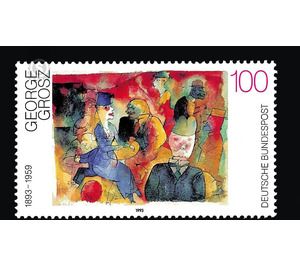German painting of the 20th century (2) - Germany / Federal Republic of Germany 1993 - 100 Pfennig
Theme: Art & Culture
| Country | Germany / Federal Republic of Germany |
| Issue Date | 1993 |
| Face Value | 100.00 |
| Color | multi-colored |
| Perforation | K 13 3/4: 14 |
| Printing Type | Multicolor offset printing |
| Stamp Type | Postage stamp |
| Item Type | Stamp |
| Chronological Issue Number | 1529 |
| Chronological Chapter | GER-BRD |
| SID | 126487 |
| In 44 Wishlists | |
George Grosz (1893-1959), who worked in Berlin until 1933 and then emigrated to New York, was perhaps the harshest prosecutor of militarism, capitalism and nationalism in his drawings, prints, watercolors and paintings. After a severe psychological crisis as a result of his experiences as an infantryman during the First World War, works such as the »Café« (1918/19) were created in which Grosz sought to capture the vulgar and brutalities of metropolitan reality in the Berlin of the post-war years with the most sparing of drawing means. The human alienation and commodity character of interpersonal relationships in a world dictated by the dictates of purchasing power became the central themes of his art. Grosz thus denied any decorative claim to painting and created, as Günther Anders aptly described it, "anti-images" that break the sham of everyday life. His caricature drawings expose the bourgeois habitus as a mask under which a human being led by lower instincts and impulses hides. Unscrupulous businessmen, arrogant bureaucrats, war cripples, and prostitutes populate his street, cafe, and brothel scenes with which he met with public rejection, even indignation. It is significant that Grosz published his autobiography under the title "A Little Yes and a Big No."


